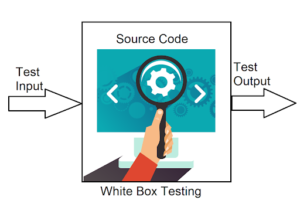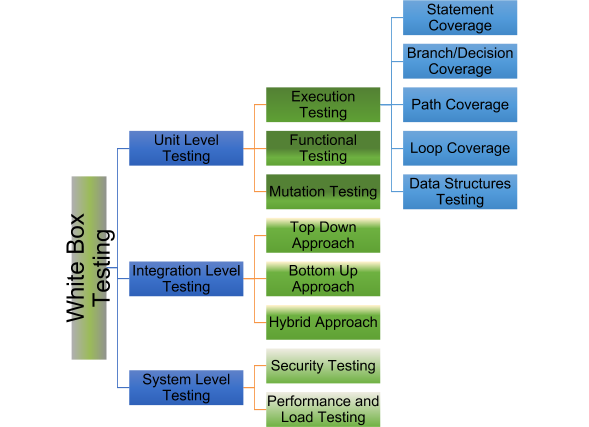Accelerate Success with AI-Powered Test Automation – Smarter, Faster, Flawless
Start free trialThe software development process involves understanding customer requirements, analysing them for feasibility, followed by designing, coding, testing and implementation.
Testing is a crucial step of the software development cycle as it ensures that all the requirements have been converted into a successful end product.
The decision of choosing the right approach for testing a software is critical. Ideally, the approach should be a healthy mix of various techniques to cover all possible scenarios. The two most commonly used approaches are White Box and Black Box testing.
White box testing requires the tester to know all the functional and design details of the module/code that is being tested. The tester needs to have in-depth knowledge of the requirements, design and even code, as well as the desired outcome.
Black Box Testing, also known as functionality testing or behavioural testing, essentially requires the testers to evaluate the functionality of the software without looking at details of the code.
In this article, we will explore the fundamentals of White Box testing and its importance in testing any software.
White-Box testing
White-box testing is used to test the structure and business logic of the program being developed.
In order to test the code thoroughly, the testing professional needs to have good knowledge of the programming language, the set standards for the code and design fundamentals. Since they have full access to the code, it is important for them to know the details of the software development process, before the testing commences.
White-Box Testing is known by several other names, like, Glass box testing, Clear Box testing, Open Box testing, Structural testing, Path Driven Testing or Logic driven testing.
Testing can be done using either Static or Dynamic approach. Static/Dynamic refers to the state of system under test (running/dynamic, or stopped/static).
- Static Analysis requires code walk through by various stakeholders, who read and analyse code for possible defects or deviation from desired functioning. This process also ensures that the code has been developed following defined processes and standards of the Organization. It is also called Structural Analysis or Verification.
- Dynamic Analysis involves executing and analysing the code in a test environment. It focus on behaviour. Since dynamic testing validates the outcomes, it is also known as Validation.
White Box testing largely follows the Dynamic approach of testing.
White-Box Testing Process
White box testing follows a process, wherein each aspect of the software is tested thoroughly by the testing team to ensure its quality and adherence to expected norms.
The process for White box testing at any level of testing is more or less the same and involves the following steps:
- Understand the languages and tools used in development of the software
- Understand the Source Code
- Write test cases for every flow and coverage possibility
- Execute test cases.
- Analyse and record the results
White Box Testing at various levels of the Testing Process
White-box testing can be applied at the Unit, Integration and System levels of the software testing process.
The diagram below provides an idea about the levels at which White Box Testing can be applied.
White Box Testing at Unit Testing Level
Unit testing is done at the basic level, as and when the programmer develops a fully functional module, aka unit of code. The module is tested independent of other modules or sub modules. It has its own set of inputs specific to the function it is expected to perform.
White Box testing at Unit Test Level involves different types of testing. Some important approaches are discussed below:
- Execution Testing: It involves deep checking the code to ensure all possible aspects have been covered. It involves:
- Statement Coverage: Statement Coverage is a White Box Test design technique which ensures that each and every line of code has been executed at least once.
- Branch/Decision coverage: Branch coverage is a testing technique which ensures that each and every decision making point and its possible outcomes have been tested at least once with different input parameters.
- Path coverage: Path Coverage ensures that each and every path of the code has been traversed at least once. It is imperative to ensure that all segments of Control structures have been covered for a complete path coverage.
- Loop coverage: Loop coverage ensures that all loops have been executed zero times, at least once or more than once within their boundary values. It is important to test the exit condition of the loop for these cases.
- Data Structures Test: All data structures have to be tested for extreme conditions. For example: Stack overflow issues sometimes go undetected if not handled properly.
- Functional Testing – The Functional Testing technique involves testing the functionality of the code segment based on specific inputs to verify and validate the expected outputs.
- Mutation Testing – Every time a code is fixed to rectify a bug, there are chances of introducing another bug. Mutation testing looks into such scenarios.
White Box Testing at the Integration Level
White box testing at the integration level focuses on testing the interfacing between various modules to ensure that they work in tandem with each other to produce the desired results. It can be done as and when fully functional modules or sub modules are completed.
Integration testing can be done using the following approaches:
- Top-Down Approach: In this type of testing, the high-level modules are tested first and then low-level modules. Finally the low-level modules are integrated with a high level module to ensure that the system is working as intended. Stubs are used in case low level modules are not ready at time of testing. Stubs simulate the functionality of an actual software module.
- Bottom-Up Approach: In this type of testing, the lowest level modules are tested first and then high-level modules. Finally integrating them to ensure proper system flow. In case a higher level module is not ready at the time of testing, then Driver modules are used to invoke the module under test by providing test inputs.
- Hybrid (Top and Bottom Combined) Approach
There are times when new modules are added to address the new requirements or reflect changes in functionality. Incremental integration testing is performed to test the seamless integration of these new/changed modules.
White Box Testing at the System Level
System Testing is performed on the completed product to check if it meets the specification requirements. By and large, Black box testing techniques are used for System level testing, but for some specific scenarios White Box testing techniques can also be applied to this level. The test cases developed at Unit and Integration level testing can be recycled and modified for System level testing.
- Security Testing
Security testing, also known as Vulnerability or Penetration Testing, is performed to test the system’s robustness to protect itself from unauthorized access. The test cases can be developed on the basis of security requirements of the software. It helps in detecting and analysing security risks to the system from external threats.
2. Performance and load testing
Performance testing involves testing the response time, stability, speed and reliability of a software in the run time environment. It identifies any performance bottlenecks and potential crashes in extreme conditions.
Advantages of White Box Testing
- Testing can start in early stages of the Software Development Cycle to concentrate on independent code units.
- Since the tester is well aware of the functioning of the code, formulating the test case becomes easier for effective testing.
- White box testing ensures traceability of test cases right to the source, thus ensuring adaptability of testing in case there is any change in the code.
- It helps in code optimization, as redundant pieces of code can be removed with help of branch coverage and statement coverage testing.
- Memory leaks, which tend to make the program slower, are hard to detect unless testing is performed at the basic level. White box testing helps in detecting possible leaks.
- White-Box Test cases can be easily automated.
Disadvantages of White Box Testing
While it may sound like a perfect way to test, it has its own drawbacks. Most significant being:
- White box testing can be complex and expensive.
- It is an expensive approach in terms of skilled resources and man hours.
- Every time there is a change in implementation the test cases have to be rewritten entirely, which is a time consuming process.
- It is practically impossible to cover each and every aspect of a huge source code.
White Box Testing Tools
Several White Box testing tools are available in market. Some commonly used ones are listed below:
- For programs written in C/C++
- CppUnit
- CppTest
- RCUnit
- For programs written in Java and/or using Java Scripts
- JSUnit
- JUnit
- EclEmma
- For .Net and C#
- NUnit
- csUnit
- VeraCode: It supports several application languages like .NET, C++, JAVA etc. and also aids in testing the security of the desktop, web as well as mobile applications.
Conclusion
White box testing and black box testing are both necessary for enterprise applications. In addition, with Webomates CI/CD system a company can integrate their whitebox tests with their black box tests and run the entire suite in minutes, prior to pushing a new software build into production.
At Webomates, we have optimized testing using the black-box testing approach through combining our patented Selenium based Automation and Artificial Intelligence with crowdsource and manual testing. We provide peace of mind during deployment, at significantly lower total costs. We offer a regression / feature testing service, to not only guarantee Full regression of every test case (even modified ones) in under 24 Hours but also to provide triaged video defects. Our customers spend only 1 hour a week on a Full Regression of their software!
If you are interested in learning more about Webomates’ CQ service please click here and schedule a demo or reach out to us at info@webomates.com
Tags: Software Testing, White Box testing




4 replies on “White Box Testing”
Really worth reading !!
Thanks Kowcik!
Everyone must read this blog, this all provided knowledge are unique than other Software testing blog ,Sharing very deep knowledge about black box testing.
Thanks,keep updating.
Very nice post about white box testing:)